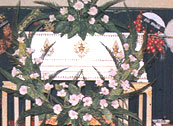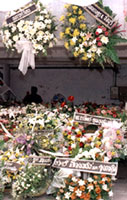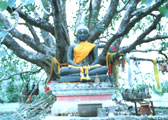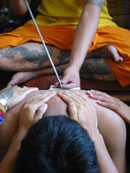Passing Away in Thailand
Once while walking on the island of Ko Kret, a small island in the Chao Phraya River in Bangkok, I came across a great festival. There were tents set up on a temple ground and people were laughing, eating, and drinking. A singer was jumping and hopping around with great energy. People were dancing and it was loud. A birthday party or anniversary or wedding for sure, I thought. Wrong, it was a funeral party, and I was confused.
My second experience with a Thai funeral happened in Surat Thani, a southern province often used as a stop over for people on the way to Ko Samui. I was wandering without aim along the streets when I spotted flashing blasts of lights coming out from a large doorway. A disco? Looking inside revealed dozens of strands of neon flashing, pulsating, swirling lights wrapped around a coffin. Even the flowers were decorated and flashing. I was totally amazed.
The third funeral I bumped into was at Donsak temple in Kanchanaburi province. It was a Chinese funeral, festive with lights, monks chanting, food, and chatting. I was invited in, given a drink, and even some explanations of the event by a friendly guest.
Chinese funeral, festive with lights, monks chanting, food, and chatting. I was invited in, given a drink, and even some explanations of the event by a friendly guest.
A paper house at least the size of a large office desk stood on one wall. The family had built everything the departed would need in the next life out of paper. The house had furniture, a satellite dish, air-conditioning, a stereo, a rice-cooker, fans and more. Also included (on the lawn) were credit cards, writing set, a passport, and a medical bag, to name a few. It was all to be lit on fire with the body at midnight. The coffin was elevated in the air surrounded by flashing white lights and non-flashing flowers.
My last experience with death in Thailand was with a dead body rather than a funeral. We got lost driving in Mae Hong Song and did a U-turn through some large hospital grounds. It was a national holiday and there was a sunny and festive atmosphere out in front of the building. Many of the patients were lounging on the grass with their various crutches, wheelchairs, and bandages. They formed quite a crowd in a park-like atmosphere.
the patients were lounging on the grass with their various crutches, wheelchairs, and bandages. They formed quite a crowd in a park-like atmosphere.
As I watched this scene two men rolled a corpse right through the middle of it. The body was covered in a thin green cloth. Only two bare feet were sticking out the end of the stretcher. Clearly dead. Nobody batted an eye, except me.
Moons ago I worked in two different hospitals in America. I am familiar with the top-secret modes of corpse transportation, the hidden back rooms for autopsies, and the back door exits for the dead. I have also attended some funerals. They were far from festive. Actually I felt the entire atmosphere was designed to make me feel as sad and devastated as possible. I definitely sense a different attitude about death and dying in Thailand.
I am not an expert on Buddhism nor would I try to explain the meaning of life and death for an entire nation or even the individuals I have seen attending funerals. I cannot tell you how they felt, only that on the outside they seemed to have a more cheerful or positive approach to the event. I have also noticed that it is common for people to take photographs throughout a funeral. This is something I would never do back home. The event is something I do not particularly want to remember.
seen attending funerals. I cannot tell you how they felt, only that on the outside they seemed to have a more cheerful or positive approach to the event. I have also noticed that it is common for people to take photographs throughout a funeral. This is something I would never do back home. The event is something I do not particularly want to remember.
I recently read the book Phra Farang: An English Monk in Thailand (http://www.bangkokpost.net/postbooks/). Phra Peter reports his first Thai funeral experience in the following way:
“Everything, including the coffin, was covered in flashing fairy lights and the whole display was back-lit with green neon. The room was quite small and contained not only the coffin and accessories but also a 5-piece brass and percussion band, the 9 monks and dozens of villagers. As villagers arrived at the house, each would approach the coffin and knock a few times on one end. We ate our breakfast sitting on the floor with the 8-foot high flashing coffin towering over us while the band played a very mournful dirge.
Although I found it quite bizarre, it was not at all undignified. The lights and colour were, I think, a reflection of the Thai people’s ‘healthy’ attitude to death. It is a time for grief but the family try to make the atmosphere as bright and cheerful as possible because it is not necessarily an unhappy time for the deceased who, hopefully, is on their way to a better life.”
This attitude and approach to death has provided me with food for thought regarding my own relationship to the subject. I know that one day I will die. I see acceptance and non-fear of death as a healthy attitude. I accept academically that life is a state of impermanence.
Back in my university days I wrote on my bedroom wall “This too will pass.” I meant it as a reminder for both great and horrible moments in my life that would all inevitably pass me by.
“I too will pass” is difficult for me to grasp. I’m still working on it.
